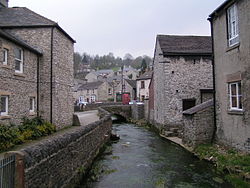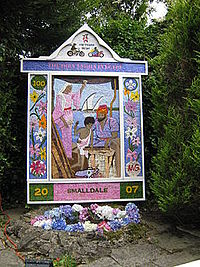Bradwell, Derbyshire
| Bradwell | |
| Derbyshire | |
|---|---|
 Bradwell Brook | |
| Location | |
| Data | |
| Population: | 1,416 (2011) |
| Post town: | Hope Valley |
| Postcode: | S33 |
| Dialling code: | 01433 |
| Local Government | |
| Council: | Derbyshire Dales |
| Parliamentary constituency: |
High Peak |
Bradwell is a village in Derbyshire, in the Peak District. It is a little to the south of the main body of the Hope Valley but is usually included among its villages.
The population of the civil parish taken at the 2011 Census was 1,416.
History
Pre-history to the Roman period
A Mesolithic pebble mace-head was found in Smalldale and a Mesolithic lithic working site was discovered when a site near Bradwell Moor Barn was excavated.[1][2] A number of Neolithic axes have been found in the village too.[3][4][5][6]
A Bronze Age barrow and the remains of a cist with a skeleton was found in 1891.[7] A Late Bronze Age socketed bronze axehead was found at a property in Hungry Lane in 1940, which is now held by Buxton Museum.[8]
A few Roman remains have been found in the village, associated with the nearby Navio fort near Brough-on-Noe, including a Roman bath. Coins from the reign of Vespasian[9] and Constantine the Great[10] have been discovered and a Roman pig of lead has also been found in the village.[11]
Middle Ages
Grey Ditch is a mediæval earthwork and a Scheduled Monument. Ceramic finds and the fact that the feature overlays the Roman road, Batham Gate, indicate that Grey Ditch is post-Roman, though no firm date has been established to tell whether it was cast up by Britons against the Anglo-Saxons, or the latter’s kingdoms against each other.[12]
The Domesday Book records that in 1066 Bradwell was held by Leofing, Owine of Bradwell and Sprot of Bradwell. By 1086 William Peverel is listed as both Lord and Tenant-in-chief. The population in 1086 was 8 villagers.[13]
Hazlebadge Hall, dating from 1549, is a Grade II* listed building immediately south of the village in the adjacent parish of Hazlebadge.[14]
Modernity
The oldest surviving public house in Bradwell is the White Hart. It was constructed in 1676.
Nonconformism was popular in Bradwell. In 1747 John Wesley preached in Towngate. In 1754 a Presbyterian chapel was built in the village. This became Unitarian at the end of the 18th century and is now used as a local scout headquarters.[15] A General Baptist chapel opened in 1790. This was used by Primitive Methodists as a Sunday school in the 20th century.[16] A Wesleyan Methodist chapel opened in 1807. It was restored and extended 1891. It is now a Methodist church. A Primitive Methodist chapel was constructed in 1845, extended in 1878, and closed in 1972.
Historically Bradwell was part of Hope parish until 1868 when the Anglican Church, St Barnabas, opened. Samuel Fox, inventor of the Paragon umbrella frame, donated £100 towards the cost of constructing the church.
The village grew again in the eighteenth century around lead mining.
Today, Bradwell has become a settlement for commuters.
Culture and community

The village has a traditional well dressing event.[17] and holds a carnival each year, usually in August.
Sport
Bradwell Sports Club offers facilities for football, tennis and multi sports. The club was founded in 1947.[18]
Outside links
| ("Wikimedia Commons" has material about Bradwell, Derbyshire) |
References
- ↑ National Monuments Record: No. 309589 – Bradwell
- ↑ National Monuments Record: No. 1212216 – Bradwell
- ↑ National Monuments Record: No. 309584 – Bradwell
- ↑ National Monuments Record: No. 606487 – Bradwell
- ↑ National Monuments Record: No. 309557 – Bradwell
- ↑ National Monuments Record: No. 309548 – Bradwell
- ↑ National Monuments Record: No. 309504 – Bradwell
- ↑ National Monuments Record: No. 309551
- ↑ National Monuments Record: No. 309545
- ↑ National Monuments Record: No. 309581 – Bradwell
- ↑ National Monuments Record: No. 309513 – Bradwell
- ↑ National Heritage List 1017662: The Grey Ditch (Scheduled ancient monument entry)
- ↑ Bradwell, Derbyshire in the Domesday Book
- ↑ National Heritage List 1356169: Hazlebadge Hall (Grade II* listing)
- ↑ National Monuments Record: No. 1498328 – Bradwell
- ↑ National Monuments Record: No. 1498329
- ↑ Derbyshire Welldressing
- ↑ Creative, Brightstar. "Bradwell Sports Club : Home". http://bradwellsportsclub.co.uk/index.html.
